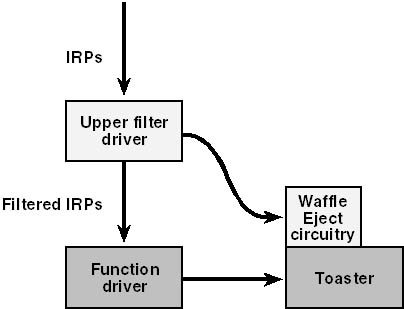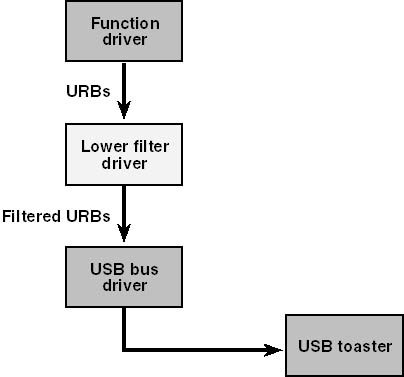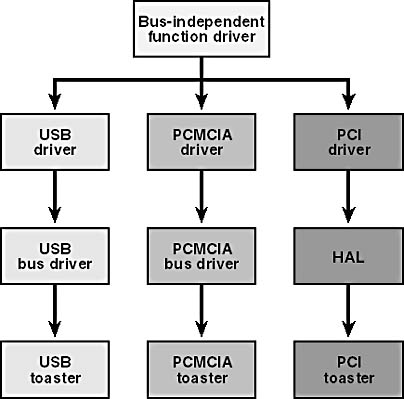Filter Drivers
[Previous] [Next]
The Windows Driver Model assumes that a hardware device can have several drivers that each contribute in some way to the successful management of the device. The WDM accomplishes the layering of drivers by means of a stack of device objects. I discussed this concept in Chapter 2, "Basic Structure of a WDM Driver." Up until now, I've been talking exclusively about the function driver that manages the main functionality of a device. In this section, I'll describe how you write a filter driver that resides above or below the function driver and modifies the behavior of the device in some way by filtering the I/O request packets (IRPs) that flow through it.
A filter driver that's above the function driver is called an upper filter driver; a filter driver that's below the function driver (but still above the bus driver) is called a lower filter driver. The mechanics of building either type of filter are exactly the same, even though the drivers themselves serve different purposes. In fact, you build a filter driver just as you build any other WDM driver—with a DriverEntry routine, an AddDevice routine, a bunch of dispatch functions, and so on.
The intended purpose of an upper filter driver is to facilitate supporting a device that behaves in most respects like a generic device of its class but that has some additional functionality. You can rely, perhaps, on a generic function driver to support the generic behavior. To deal with the extra functionality, you write an upper filter driver to intervene in the flow of I/O requests. To give a silly example, suppose there existed a standard class of toaster device for which someone had written a standard driver. And suppose that your particular toaster had an Advanced Waffle Eject feature that caused your toaster to pop toasted waffles two feet into the air. Controlling this AWEsome feature would be a natural job for an upper filter driver. See Figure 9-1.

Figure 9-1. Role of an upper filter driver.
Another use for upper filter drivers is to compensate for bugs in the hardware or in the function driver. If you're going to deploy a filter driver for this purpose, Microsoft implores you to version-stamp the driver and, insofar as it's under your control, to change the version number of whatever component you're compensating for when the bug someday gets fixed. Otherwise, it will be harder for Microsoft to install automatic updates.
Lower filter drivers can't intervene in the normal operation of a device with which the function driver communicates directly. That's because the function driver will implement most substantive requests by making hardware abstraction layer (HAL) calls that directly access the hardware. The filter driver, of course, sees only those IRPs that something above chooses to pass down to it, and it never knows about the HAL calls.
A lower filter driver might find employment in the stack of drivers for a USB (universal serial bus) device, however. For such devices, the function driver uses internal control IRPs as containers for USB request blocks (URBs). A lower filter driver could monitor and modify these IRPs, perhaps. See Figure 9-2.

Figure 9-2. Role of a lower filter driver.
Another possible use for a lower filter driver, suggested by one of my seminar students, is to help you write a bus-independent driver. Imagine a device packaged as a PCI (Peripheral Component Interconnect) expansion card, a PCMCIA (Personal Computer Memory Card International Association) card, a USB device, and so on. You could write a function driver that is totally independent of the bus architecture, except that it wouldn't be able to talk to the device. You'd also write several lower filter drivers, one for each possible bus architecture, as illustrated in Figure 9-3. You'd install the appropriate one of these for a particular instance of the hardware. When your function driver needed to talk to the hardware, it would send an IRP (perhaps an IRP_MJ_INTERNAL_DEVICE_CONTROL) down to the filter.

Figure 9-3. Using lower filter drivers to achieve bus independence.
DriverEntry Routine
The DriverEntry routine for a filter driver is very similar to that for a function driver. The major difference is that a filter driver must install dispatch routines for every type of IRP, not just for the types of IRP it expects to handle:
extern "C" NTSTATUS DriverEntry(PDRIVER_OBJECT DriverObject, PUNICODE_STRING RegistryPath) { DriverObject->DriverUnload = DriverUnload; DriverObject->DriverExtension->AddDevice = AddDevice; for (int i = 0; i < arraysize(DriverObject->MajorFunction); ++i) DriverObject->MajorFunction[i] = DispatchAny; DriverObject->MajorFunction[IRP_MJ_POWER] = DispatchPower; DriverObject->MajorFunction[IRP_MJ_PNP] = DispatchPnp; return STATUS_SUCCESS; } |
A filter driver has a DriverUnload and an AddDevice function just as any other driver does. I filled the major function table with the address of a routine named DispatchAny that would pass any random request down the stack. I specified specific dispatch routines for power and Plug and Play (PnP) requests.
The reason that a filter driver has to handle every conceivable type of IRP has to do with the order in which driver AddDevice functions get called vis-à-vis DriverEntry. In general, a filter driver has to support all the same IRP types that the driver immediately underneath it supports. If a filter were to leave a particular MajorFunction table entry in its default state, IRPs of that type would get failed with STATUS_INVALID_DEVICE_REQUEST. (The I/O Manager includes a default dispatch function that simply completes a request with this status. The driver object initially comes to you with all the MajorFunction table entries pointing to that default routine.) But you won't know until AddDevice time which device object(s) are underneath you. You could investigate the dispatch table for each lower device driver inside AddDevice and plug in the needed dispatch pointers in your own MajorFunction table, but remember that you might be in multiple device stacks, so you might get multiple AddDevice calls. It's easier to just declare support for all IRPs at DriverEntry time.
AddDevice Routine
Filter drivers have AddDevice functions that get called for each appropriate piece of hardware. You'll be calling IoCreateDevice to create an unnamed device object and IoAttachDeviceToDeviceStack to plug in to the driver stack. In addition, you'll need to copy a few settings from the device object underneath you:
NTSTATUS AddDevice(PDRIVER_OBJECT DriverObject, PDEVICE_OBJECT pdo) { PDEVICE_OBJECT fido; NTSTATUS status = IoCreateDevice(DriverObject, sizeof(DEVICE_EXTENSION), NULL, FILE_DEVICE_UNKNOWN, 0, FALSE, &fido); if (!NT_SUCCESS(status)) return status; PDEVICE_EXTENSION pdx = (PDEVICE_EXTENSION) fido->DeviceExtension; _ _try { pdx->DeviceObject = fido; pdx->Pdo = pdo; PDEVICE_OBJECT fdo = IoAttachDeviceToDeviceStack(fido, pdo); pdx->LowerDeviceObject = fdo; fido->Flags |= fdo->Flags & (DO_DIRECT_IO | DO_BUFFERED_IO | DO_POWER_PAGABLE | DO_POWER_INRUSH); fido->DeviceType = fdo->DeviceType; fido->Characteristics = fdo->Characteristics; fido->Flags &= ~DO_DEVICE_INITIALIZING; } _ _finally { if (!NT_SUCCESS(status)) IoDeleteDevice(fido); } return status; } |
The part that's different from a function driver is shown in boldface. Basically, we're propagating a few flag bits, the DeviceType value, and the Characteristics value from the device object next beneath us. We need to make these copies because the I/O Manager bases some of its decisions on what it sees in the topmost device object. In particular, whether a read or write IRP gets a memory descriptor list (MDL) or a system copy buffer depends on what the top object's DO_DIRECT_IO and DO_BUFFERED_IO flags are. We don't need to copy the SectorSize or AlignmentRequirement members of the lower device object—IoAttachDeviceToDeviceStack will do that automatically.
NOTE
The reason I told you that you have to declare your choice of buffered versus direct I/O in AddDevice and that you can't change you mind afterward should now be clear: a filter driver might copy your settings at AddDevice time and won't have any way to know about a later change.
There's ordinarily no need for a filter device object (FiDO) to have its own name. If the function driver names its device object and creates a symbolic link, or if the function driver registers a device interface for its device object, an application will be able to open a handle for the device. Every IRP sent to the device gets sent first to the topmost FiDO driver, whether or not that FiDO has its own name.
Do not use the FILE_DEVICE_SECURE_OPEN characteristics flag when you create a FiDO object. The PnP Manager propagates this flag, and a few others, up and down the device object stack. It's not your decision whether to enforce security checking on file opens—it's the function driver's and maybe the bus driver's.
Dispatch Routines
You write a filter driver in the first place because you want to modify the behavior of a device in some way. Therefore, you'll have dispatch functions that do something with some of the IRPs that come your way. But you'll be passing most of the IRPs down the stack, and you pretty much know how to do this already:
NTSTATUS DispatchAny(PDEVICE_OBJECT fido, PIRP Irp) { PDEVICE_EXTENSION pdx = (PDEVICE_EXTENSION) fido->DeviceExtension; NTSTATUS status = IoAcquireRemoveLock(&pdx->RemoveLock, Irp); if (!NT_SUCCESS(status)) return CompleteRequest(Irp, status, 0); IoSkipCurrentIrpStackLocation(Irp); status = IoCallDriver(pdx->LowerDeviceObject, Irp); IoReleaseRemoveLock(&pdx->RemoveLock, Irp); return status; } NTSTATUS DispatchPnp(PDEVICE_OBJECT fido, PIRP Irp) { PDEVICE_EXTENSION pdx = (PDEVICE_EXTENSION) fido->DeviceExtension; NTSTATUS status = IoAcquireRemoveLock(&pdx->RemoveLock, Irp); if (!NT_SUCCESS(status)) return CompleteRequest(Irp, status, 0); PIO_STACK_LOCATION stack = IoGetCurrentIrpStackLocation(Irp); ULONG fcn = stack->MinorFunction; IoSkipCurrentIrpStackLocation(Irp); status = IoCallDriver(pdx->LowerDeviceObject, Irp); if (fcn == IRP_MN_REMOVE_DEVICE) { IoReleaseRemoveLockAndWait(&pdx->RemoveLock, Irp); IoDetachDevice(pdx->LowerDeviceObject); IoDeleteDevice(fido); } else IoReleaseRemoveLock(&pdx->RemoveLock, Irp); return status; } NTSTATUS DispatchPower(PDEVICE_OBJECT fido, PIRP Irp) { PoStartNextPowerIrp(Irp); PDEVICE_EXTENSION pdx = (PDEVICE_EXTENSION) fido->DeviceExtension; NTSTATUS status = IoAcquireRemoveLock(&pdx->RemoveLock, Irp); if (!NT_SUCCESS(status)) return CompleteRequest(Irp, status, 0); IoSkipCurrentIrpStackLocation(Irp); status = PoCallDriver(pdx->LowerDeviceObject, Irp); IoReleaseRemoveLock(&pdx->RemoveLock, Irp); return status; } |
It's necessary, by the way, to acquire and release the remove lock for a filter driver's device object, as shown in these examples. The initial call to IoAcquireRemoveLock checks whether a device removal is currently pending for the FiDO. If so, the dispatch function fails the IRP immediately with STATUS_DELETE_PENDING, the only nonsuccess value that IoAcquireRemoveLock ever returns. While the filter owns its remove lock in one dispatch function, another thread that might be trying to process an IRP_MN_REMOVE_DEVICE inside DispatchPnp will block inside IoReleaseRemoveLockAndWait. What's thereby prevented is the call to IoDetachDevice, which might allow the lower device object to disappear. Our own device object is protected from deletion by a reference that was obtained by the caller before sending us this IRP—by using IoGetAttachedDeviceReference, for example.
Except for IRP_MJ_PNP, all dispatch functions in a filter driver need to be in nonpaged memory, and none should assume they're being called at PASSIVE_LEVEL. Here are two real-world examples of why this might matter. First, a lower filter for a USB device will be receiving and passing along IRP_MJ_INTERNAL_DEVICE_CONTROL requests that contain URBs. (See Chapter 11, "The Universal Serial Bus.") Some of these IRPs arrive at PASSIVE_LEVEL. Others might arrive at DISPATCH_LEVEL because they're coming from an I/O completion routine. The second example involves a disk driver, which might start out handling power requests at PASSIVE_LEVEL because it's set the DO_POWER_PAGABLE flag. The disk driver might subsequently learn that its device is being used to hold a paging file or some other special file, whereupon it will lock down its power handler and clear the DO_POWER_PAGABLE flag. All of a sudden, any filter driver in the same stack will start getting power requests at DISPATCH_LEVEL.
NOTE
You should follow this guideline when you program a filter driver: First, do no harm. In other words, don't cause drivers above or below you to fail because you perturbed anything at all in their environment or in the flow of IRPs.
EAN: 2147483647
Pages: 93